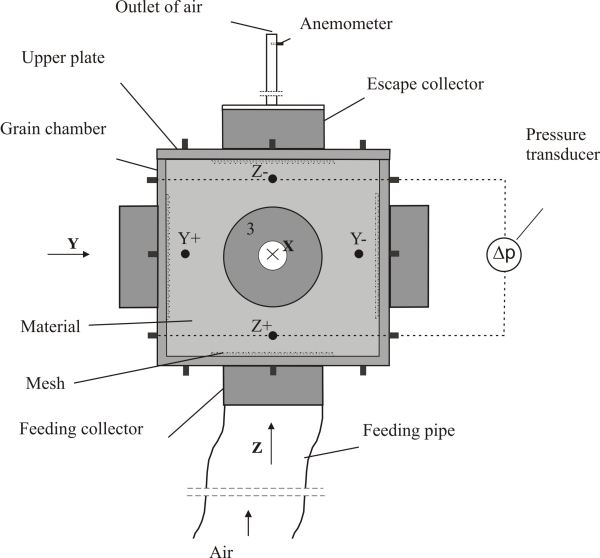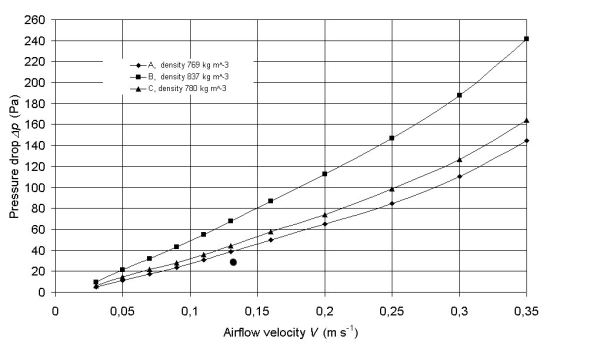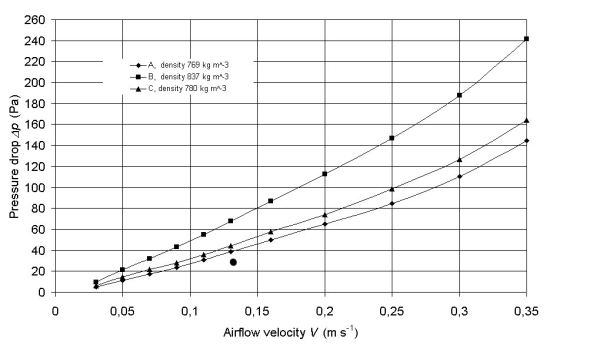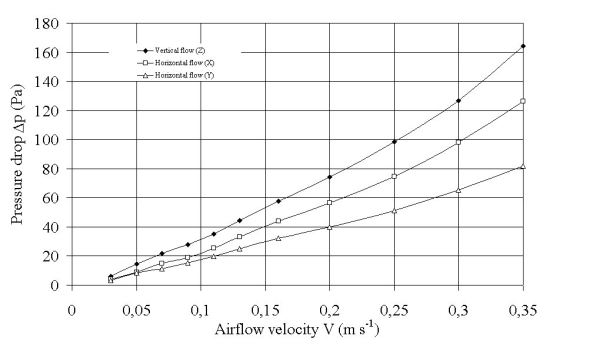Air flow resistance
- Variability of airflow resistance in wheat caused by non-homogeneity of bulk
- Influence of filling method on pressure drop in vertical direction
- Pressure drop in three directions of axial symmetric bedding
- Pressure drop in three directions of non-symmetric bedding
Variability of airflow resistance in wheat caused by non-homogeneity of bulk
A study was conducted to estimate the degree of variability of airflow resistance in wheat caused by filling method, compaction of the sample and airflow direction. Grain chamber in the form of cubical box of 0.35 m side was used. Airflow resistance along three perpendicular directions: two horizontal X and Y, and vertical direction Z was determined. In each wall of the cube circular openings 0.16 m in diameter were machined and covered with perforated steel. Each wall of the chamber was equipped with cylindrical air collectors (supply or outlet) 0.16 m in diameter and with four connectors for installation of pressure transducer. Pressure drop was measured at the distance of 0.25 m using Variable reluctance pressure transducer with accompanying equipment. Leaving the column the air flew through outlet air plenum and through the 0.05 m diameter outlet duct in that air velocity was measured. Pressure drop was measured for airflow velocity in a range from 0.03 mxs-1 to 0.35 mxs-1.

Figure 1. Schematic of the apparatus for measuring airflow resistance in cubic sample of wheat
Method A used 1 m long funnel with openings of diameters of 0.2 and 0.03 m. Method C used wedge shaped filling container as wide as the chamber width (0.35 m) and having supply and outlet slots of the width of 0.15 and 0.015 m, respectively. With the both filling methods the chamber was filled by slowly rising up the appliance that was earlier filled with grain, maintaining continuous outflow of the material. The chamber was overfilled and excess material was removed while upper surface was leveled. Method B used the same funnel that was used for method A but the chamber was filled in 8 steps with compaction of the bulk covered with plate by 10 taps with 4 kg of mass deadweight after adding each portion of grain.
Testing was performed with winter wheat of initial moisture content of 11% and uncompacted bulk density of 773 kg/m3.
Influence of filling method on pressure drop in vertical direction
Figure 2 illustrates relationships of pressure drop at a distance of 0.25 m versus airflow velocity in vertical direction Z of samples formed with the three filling methods. Pressure drop increased with an increase in bulk density and for airflow velocity V of 0.3 mxs-1 Dp was found of 118.2 Pa for filling method A, while in the case of the method B it was found of 195.1 Pa, thus 1.65 times higher.

Figure 2. Pressure drop versus air velocity in vertical direction Z for three methods of filling test chamber.
Pressure drop in three directions of axial symmetric bedding
In all tests performed airflow resistance in vertical direction Z was found higher than in horizontal directions X and Y, the finding in accord with results of other researchers. Relationships Dp(V) for filling method A and two directions of airflow vertical Z and horizontal Y are shown in Figure 4. In the whole range of airflow velocity the curve of Dp(V) for vertical direction runs above the curves obtained for horizontal directions that followed very similar paths. For the airflow velocity of 0.3 mxs-1 the pressure drop in Y direction was found of 72.2 Pa, while in Z direction it was of 111.3 Pa, that is 1.5 times higher.

Figure 3. Pressure drop versus air velocity in vertical direction Z and horizontal directions X and Y for samples formed using method A
Pressure drop in three directions of non-symmetric bedding

Figure 4 illustrates Dp(V) relationships determined for three directions X, Y and Z for C non-asymmetric filling method. The lowest found was the airflow resistance in direction Y, the highest airflow resistance in direction Z. Unlike for the methods A and B in the case of filling method C the pressure drop in direction X was in the whole range of velocity higher than that in direction Y. At airflow velocity of 0.3 mxs-1 the pressure drop in Y direction was found of 61.2 Pa, while in X direction it was of 90.1 Pa, that is approximately 1.5 times higher. Method C that used wedge shaped filling container produced grain sample that was not axially symmetric. Subsequent layers of grain were moving down the surface of natural repose cone.
- Łukaszuk J., Molenda M., Horabik J.: Wpływ upakowania i kształtu nasion na spadek ciśnienia powietrza w złożu żyta i rzepaku. Acta Agrophysica, 10(3), 593-605, 2007.
- Łukaszuk J., Molenda M., Horabik J., Szot B., Montross M.D.: Airflow resistance of wheat bedding as influenced by the filling method. Res. Agr. Eng., Vol. 54(2), 50-57, 2008.
- Łukaszuk J., Molenda M., Horabik J., Montross M.D.: Variability of pressure drop in grain generated by kernel shape and bedding method. J. Stored Products Research, 45(2), 112-118, 2009.
